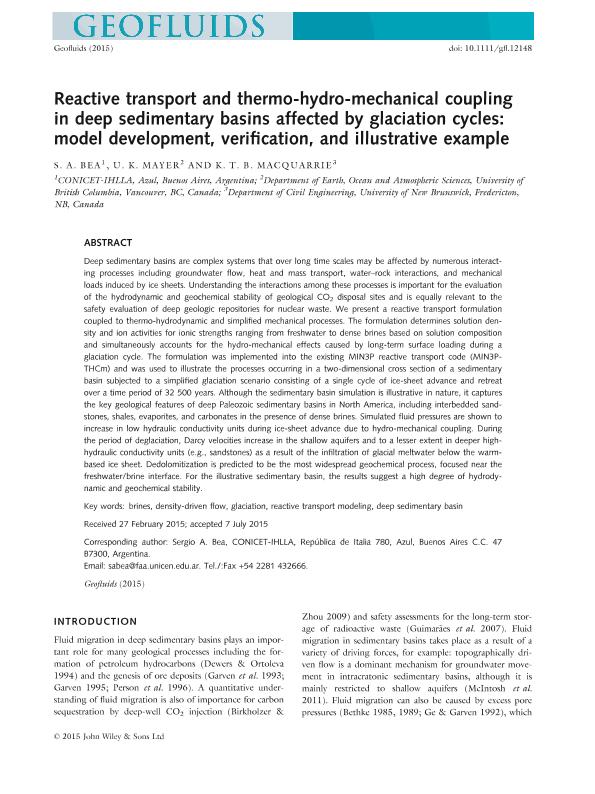Artículo
Reactive transport and thermo-hydro-mechanical coupling in deep sedimentary basins affected by glaciation cycles: Model development, verification, and illustrative example
Fecha de publicación:
05/2016
Editorial:
Wiley Blackwell Publishing, Inc
Revista:
Geofluids
ISSN:
1468-8115
Idioma:
Inglés
Tipo de recurso:
Artículo publicado
Clasificación temática:
Resumen
Deep sedimentary basins are complex systems that over long time scales may be affected by numerous interacting processes including groundwater flow, heat and mass transport, water-rock interactions, and mechanical loads induced by ice sheets. Understanding the interactions among these processes is important for the evaluation of the hydrodynamic and geochemical stability of geological CO2 disposal sites and is equally relevant to the safety evaluation of deep geologic repositories for nuclear waste. We present a reactive transport formulation coupled to thermo-hydrodynamic and simplified mechanical processes. The formulation determines solution density and ion activities for ionic strengths ranging from freshwater to dense brines based on solution composition and simultaneously accounts for the hydro-mechanical effects caused by long-term surface loading during a glaciation cycle. The formulation was implemented into the existing MIN3P reactive transport code (MIN3P-THCm) and was used to illustrate the processes occurring in a two-dimensional cross section of a sedimentary basin subjected to a simplified glaciation scenario consisting of a single cycle of ice-sheet advance and retreat over a time period of 32 500 years. Although the sedimentary basin simulation is illustrative in nature, it captures the key geological features of deep Paleozoic sedimentary basins in North America, including interbedded sandstones, shales, evaporites, and carbonates in the presence of dense brines. Simulated fluid pressures are shown to increase in low hydraulic conductivity units during ice-sheet advance due to hydro-mechanical coupling. During the period of deglaciation, Darcy velocities increase in the shallow aquifers and to a lesser extent in deeper high-hydraulic conductivity units (e.g., sandstones) as a result of the infiltration of glacial meltwater below the warm-based ice sheet. Dedolomitization is predicted to be the most widespread geochemical process, focused near the freshwater/brine interface. For the illustrative sedimentary basin, the results suggest a high degree of hydrodynamic and geochemical stability.
Archivos asociados
Licencia
Identificadores
Colecciones
Articulos(CCT - TANDIL)
Articulos de CTRO CIENTIFICO TECNOLOGICO CONICET - TANDIL
Articulos de CTRO CIENTIFICO TECNOLOGICO CONICET - TANDIL
Citación
Bea, Sergio Andrés; Mayer, U. K.; Macquarrie, K. T. B.; Reactive transport and thermo-hydro-mechanical coupling in deep sedimentary basins affected by glaciation cycles: Model development, verification, and illustrative example; Wiley Blackwell Publishing, Inc; Geofluids; 16; 2; 5-2016; 279-300
Compartir
Altmétricas




